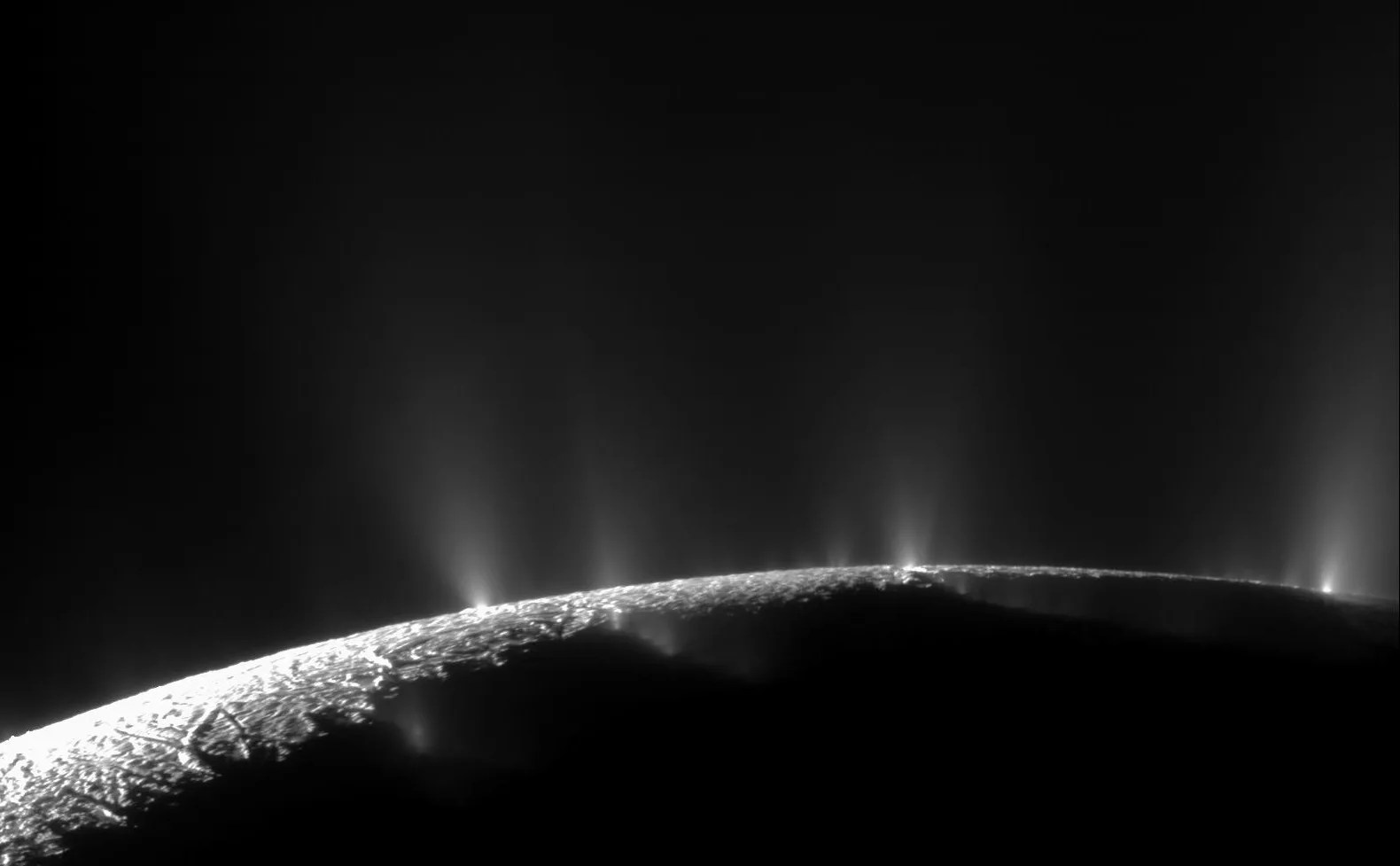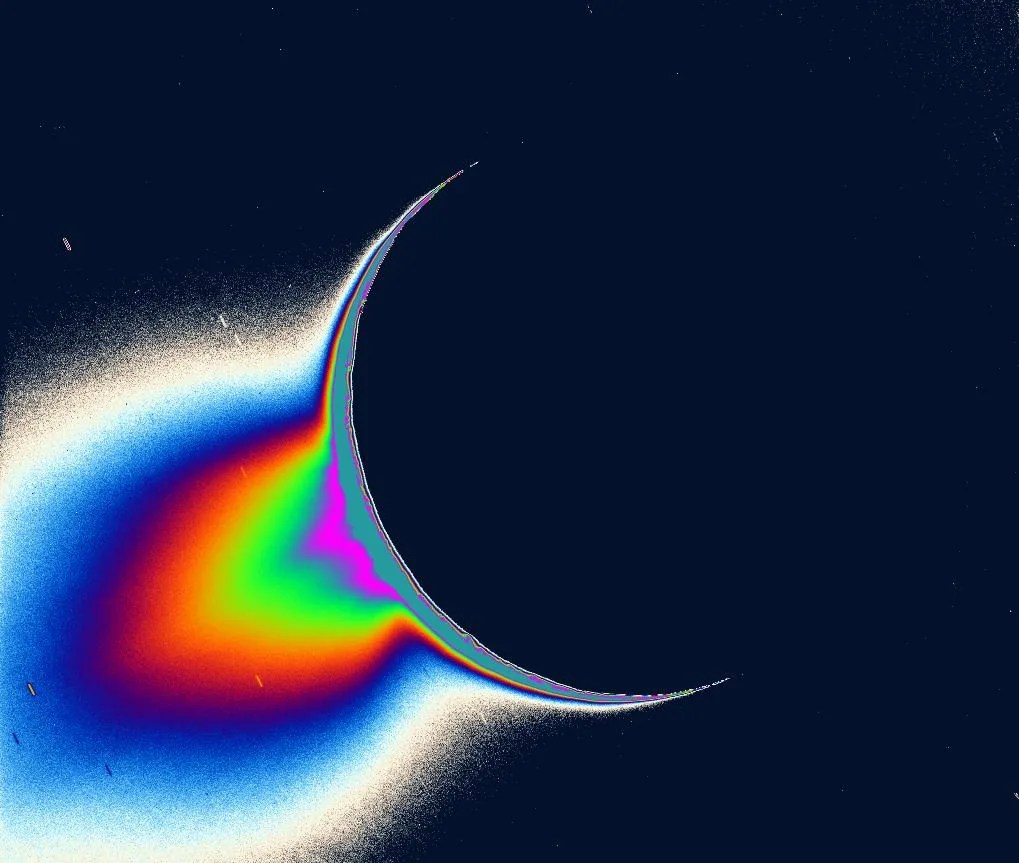9 min read

February 2005: There's Something Strange about Enceladus
The magnetometer aboard NASA's robotic Cassini spacecraft discovers something -- perhaps an atmosphere -- is pushing against Saturn's magnetic field around Enceladus, a small, icy moon of Saturn barely 300 miles (500 kilometers) in diameter. There is evidence that gases may be originating from the moon's surface or interior. Cassini's cosmic dust analyzer records thousands of hits from tiny particles of dust or ice, possibly coming from a cloud around the moon or from the adjacent E ring, a broad ring of dust-sized ice particles in which Enceladus orbits. The science team makes plans to return to Enceladus for a closer look. More ›
July 2005: A Big Surprise at a Small Moon
During this pivotal flyby, the Cassini cameras obtain new, detailed images of the south polar region of Enceladus. The images reveal a surprisingly youthful and complex terrain, almost entirely free of impact craters. The area is littered with house-sized ice boulders carved by unique tectonic patterns found only in this region of the moon. To their amazement, Cassini scientists detect a huge cloud of water vapor over the area -- and relatively warm fractures in the crust that are supplying the cloud of water vapor and ice particles that extend into space. Cassini data also confirms that this activity is the major source of material in the E ring. More ›
March 2006: Liquid Water Beneath the Surface

Cassini scientists announce they have found evidence of liquid water reservoirs feeding the Enceladus plume, possibly in the form of geysers. After examining high-resolution Cassini images and other data showing icy jets ejecting large quantities of particles at high speed, scientists rule out the idea that the particles are produced by or blown off the moon's surface by vapor created when warm water ice converts to a gas. Instead, they find evidence that the jets might be erupting from near-surface pockets of liquid water. More ›
October 2007: Geysers and "Tiger Stripes"
Analysis of images from Cassini provide conclusive evidence that the jets originate from near the hottest spots on the moon's "tiger stripe" fractures, which straddle the south polar region of Enceladus. Members of Cassini's imaging team use two years' worth of pictures of the geologically active moon to locate the sources of the most prominent jets spouting from the moon's surface. The researchers find that all of the jets appear to come from the four prominent tiger stripe fractures and, in almost every case, in the hottest areas detected by Cassini's Composite Infrared Spectrometer (CIRS). More ›
March 2008: An Organic Brew
During a close flyby, Cassini's instruments sample the plume directly, and detect a surprising brew of volatile gases, water vapor, carbon dioxide and carbon monoxide, as well as organic materials, some 20 times denser than expected. The brew is described as being "like carbonated water with an essence of natural gas." New heat maps of the surface show higher temperatures than previously known in the south polar region, with higher-than-expected temperatures running the length of the giant fissures near the south pole. More ›
August 2008: Pinpointing the Source
In a feat of interplanetary sharpshooting, Cassini identifies precisely where icy jets erupt from the surface of Enceladus. Carefully targeted pictures reveal exquisite details in the prominent south polar tiger stripe fractures from which the jets emanate. The images show the fractures are about 980 feet (300 meters) deep, with V-shaped inner walls. The outer flanks of some of the fractures show extensive deposits of fine material. Finely fractured terrain littered with blocks of ice tens of meters in size and larger surrounds the fractures. More ›
December 2008: An Active World
The closer scientists look at Enceladus, the more evidence they find of geologic activity. New high-resolution images show signs that the south polar surface changes over time, including surprising evidence of Earth-like tectonics, such as spreading of the icy crust, but with an exotic difference -- the spreading is almost all in one direction, like a conveyor belt. New data on the plume show it varies over time and has a far-reaching effect on Saturn's magnetosphere.
June 2009: Salty Evidence for Hidden Water
Scientists working on the Cassini mission detect sodium salts in ice grains of Saturn's outermost ring. The salty ice indicates that Enceladus, which is the primary source replenishing the ring with material from its jets, could harbor a large reservoir of liquid water -- perhaps an ocean -- beneath its surface. Scientists on Cassini's Cosmic Dust Analyzer (CDA) team conclude that liquid water must be present because it is the only way to dissolve the significant amounts of minerals that would account for the levels of salt detected. More ›
July 2009: Ammonia Adds to the Evidence
Researchers announce that data collected during close flybys of Enceladus definitively identifies ammonia in the plume. In space, the presence of ammonia provides strong evidence for the existence of at least some liquid water. More ›
February 2010: New Jets
Images from a November 2009 swoop over Enceladus reveal a forest of new jets spraying from the south polar region that had not been seen before, along with changes in activity among some previously observed jets. The images and composite infrared spectrometer data also yield the best 3-D image ever obtained of a tiger stripe, as well as views of regions not well-mapped previously on Enceladus, including a southern area with crudely circular tectonic patterns. More ›
October 2010: A Wobbly Clue
Scientists with the Cassini team compare a map of the gravitational tidal stress on the icy crust of Enceladus to a map of the warm zones created using Cassini's composite infrared spectrometer instrument. Areas with the most stress should overlap the warmest zones on the infrared map, but they don't exactly match. Researchers believe the discrepancy can be resolved if Enceladus wobbles slightly as it rotates. More ›
March 2011: Too Hot to Handle
Heat output from the south polar region is found to be much greater than was previously thought possible, according to analysis of data collected by Cassini CIRS. The internal heat-generated power is about 15.8 gigawatts, approximately 2.6 times the power output of all the hot springs in the Yellowstone region, or comparable to 20 coal-fueled power stations. The mechanism capable of producing so much observed internal power remains a mystery and challenges proposed models of long-term heat production inside the icy moon. More ›
September 2011: Sharing the Water
Enceladus becomes the only moon in our solar system known to substantially influence the chemical composition of its parent planet. Using data from the European Space Agency's Herschel Space Observatory, scientists find a huge donut-shaped cloud water vapor created by Enceladus encircling Saturn, which appears to be the source of water in Saturn's upper atmosphere. More ›
March 2012: Stressed Out
Images from Cassini enable scientists to correlate how jets of water vapor spray from fissures on Enceladus with the way Saturn's gravity stretches the fissures. This work gives scientists insight into the mechanics of the picturesque jets and shows that Saturn places powerful stresses on Enceladus. More ›
July 2013: Like an Adjustable Nozzle
Enceladus explorers find that the intensity of the jets of water ice and organic particles that shoot out from Enceladus depends on the moon's proximity to Saturn in the course of its not-quite-circular orbit. The geysers' "nozzles" are almost closed when Enceladus is closer to Saturn and are most open when the moon is farthest away. Scientists think this has to do with how Saturn's gravity squeezes and releases the moon. The finding adds to evidence that a liquid water reservoir or ocean lurks under the surface. More ›
April 2014: A Hint of Something Bigger
Gravity measurements based on the Doppler effect provide the first geophysical measures of the internal structure of Enceladus, and they turn out to be consistent with the existence of a hidden ocean inside the moon. The measurements suggest a large (probably regional) sea about 6 miles (10 kilometers) deep beneath the southern polar region, under an ice shell about 19 to 25 miles (30 to 40 kilometers) thick. More ›
July 2014: 101 Emanations
Scientists identify 101 distinct geysers erupting on Enceladus. Their analysis suggests it is possible for liquid water to reach all the way to its surface from the moon's underground sea. Individual geysers are found to be coincident with small hot spots, and these relationships point the way to the geysers' origin in an ocean below. More ›
March 2015: Confirming a Hydrothermal Hypothesis
Cassini provides scientists with the first clear evidence that Enceladus exhibits signs of present-day hydrothermal activity resembling that which occurs in the deep oceans of Earth. Cassini's cosmic dust analyzer (CDA) instrument repeatedly detected miniscule rock particles rich in silicon. An extensive analysis of data from the spacecraft and laboratory experiments leads researchers to the conclusion the tiny grains most likely form when hot water containing dissolved minerals from the moon's rocky interior travels upward, coming into contact with cooler water. More ›
April 2015: Tendrils into Space
Long, sinuous, tendril-like structures seen in the vicinity of Enceladus are found to originate directly from geysers erupting from its surface. Scientists show that each unique tendril structure is produced by particular sets of geysers on the moon's surface. More ›
May 2015: Curtains of Ice
One study suggests most of the eruptions might be diffuse curtains rather than discrete jets. Some features that appear to be individual jets of material erupting along the length of prominent fractures in the moon's south polar region might be phantoms created by an optical illusion. More ›
September 2015: A Global Ocean
Researchers find the magnitude of the moon's very slight wobble as it orbits Saturn can only be accounted for if its outer ice shell is not frozen solid to its interior, meaning a global ocean must be present. The finding implies the fine spray of water vapor, icy particles and simple organic molecules Cassini has observed coming from fractures near the moon's south pole is being fed by this vast liquid water ocean. More ›
April 2017: Hydrothermal Hydrogen and Potential Habitability
Scientists announce that Cassini's Ion and Neutral Mass Spectrometer detected significant amounts of hydrogen in the plume of Enceladus. From previous flybys, Cassini determined that nearly 98 percent of the gas in the plume is water, and the rest is a mixture of other molecules, including carbon dioxide, methane and ammonia. The detection of a large amount of hydrogen strongly suggests a continuous hydrothermal process, in which the sub-surface waters of Enceladus interact with rock and organic compounds. The chemistry Cassini detected is remarkably similar to that created by hydrothermal vents in oceans on Earth -- in particular low-temperature ones called "white smokers." This kind of chemistry could be used as an energy source by life -- if it happened to exist in the Enceladus ocean.







